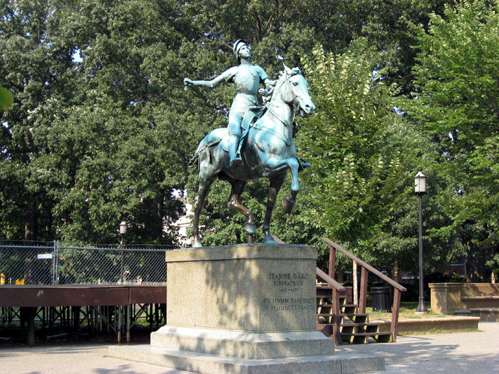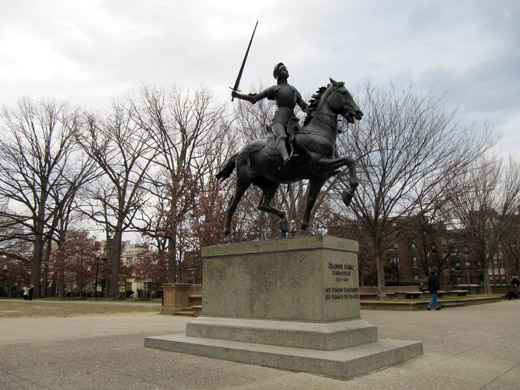“In Washington, summer is a horror beyond the telling of it,” wrote Philip K. Dick in his 1968 “Self Portrait,” echoing the more effable sentiments of sweat-soaked D.C. residents this week. Dick is so associated with California—he spent nearly his entire life there—that few science-fiction readers, and almost no Washingtonians, remember that in the late 1930s, the budding author and his mother lived in the Cleveland Park neighborhood, or that Dick’s three years here echo in his work.
Dick’s novel Puttering About in a Small Land, written in 1957 but published posthumously in 1985, views several D.C. landmarks through the gauzy lens of personal mythology. Despite his prolificity and unabashed weirdness, Dick craved mainstream success, and he grounds an early sequence in Puttering About, a realistic tale of infidelity and doomed postwar dreams, in actual Washington places: Rock Creek Park, Massachusetts Avenue, and the Tidal Basin, which a character imbues with her own anxieties:
To her the Tidal Basin and the trees had a mysterious quality; they kept the countryside here in the center of the city, as if it could not be completely suppressed. Actually she was afraid of the Tidal Basin; it was part of the lines and pools of water that had cut into the ground by the coast, the canals and rivers and streams; Rock Creek itself, and of course the Potomac. When she came near the Potomac she believed she had been removed completely away from the present; she did not accept the fact that the Potomac existed in the modern world.
In keeping with Dick’s real life, the action in Puttering About soon switches to California, but Washington remains a place of origin and a repository for obsessive memory. In the 1966 novel Now Wait for Last Year, Dick returns to Cleveland Park—naturally, by way of Mars.
Like most Dick novels, Now Wait defies easy summary, but suffice it to say that it features pharmaceutically induced time travel, a dictator who battles aliens across alternate dimensions, and ancient gazillionaire Virgil Ackerman, president of the Tijuana Fur and Dye Company, which turns alien amoebas into spaceship control spheres. With the help of antiquarians and preposterous wealth, Ackerman pioneers the creation of Martian “babylands,” hyperpersonal theme parks that recreate fondly remembered places in a patron’s life.
Amusingly, Virgil Ackerman rebuilds Philip K. Dick’s childhood in Washington, D.C., circa 1935:
Wash-35 consisted of a painstakingly elaborate reconstruction of the specific limited universe of childhood which Virgil had known, constantly refined and improved in matters of authenticity by his antique procurer—Kathy Sweetscent—without really ever being in a genuine sense changed: it had coagulated, cleaved to the dead past…at least as far as the rest of the clan were concerned. But to Virgil it of course sprouted life. There, he blossomed. He restored his flagging biochemical energy and then returned to the present, to the shared, current world which he eminently understood and manipulated but of which he did not psychologically feel himself a native.
Imagine my surprise when I learned that I live in a latter-day version of Wash-35:
The omphalos of Wash-35, a five-story brick apartment building where Virgil had lived as a boy, contained a truly modern apartment of their year 2055 with every detail of convenience which Virgil could obtain during these war years.
Dick misremembered how many floors his childhood omphalos had, but it’s still there, around the corner from me, the only apartment building on a leafy, house-lined street.

Several blocks away lay Connecticut Avenue, and, along it, stores which Virgil remembered. Here was Gammage’s, a shop at which Virgil had bought Tip Top comics and penny candy. Next to it Eric made out the familiar shape of People’s Drugstore; the old man during his childhood had bought a cigarette lighter here once and chemicals for his Gilbert Number Five glass-blowing and chemistry set.

Dick recalls doing most of those same things in his “Self-Portrait.” The drug store has gotten a facade-lift and a new name, but it’s right where Dick left it, and kids still pop in there after school to buy junk food. Dick would like the place; the scanners talk to you.
(I’ve yet to find an elderly neighbor who remembers “Gammage’s.”)
“What’s the Uptown Theater showing this week?” Harv Ackerman murmured as their ship coasted along Connecticut Avenue so that Virgil could review these treasured sights. He peered.
It was Jean Harlow in Hell’s Angels, which all of them had seen at least twice. Harv groaned.

The Uptown has shown the various Blade Runner re-releases and director’s cuts. Prometheus is playing there now.
The ship taxied from Connecticut Avenue onto McComb Street and soon was parking before 3039 with its black wrought-iron fence and tiny lawn. When the hatch slid back, however, Eric smelled—not the city air of a long-gone Terran capital—but the bitterly thin and cold atmosphere of Mars…

On a late June afternoon, the atmosphere at 3039 Macomb Street NW is anything but cold and thin, but the year could be 1935, or 2012, or 2055.
Uphill, west on Macomb, looms another Philip K. Dick landmark. After a miserable stint at an experimental school in Maryland, young Phil spent second through fourth grades here in Cleveland Park at John Eaton Elementary.

Despite a homely concrete wedge that joins Eaton’s two older buildings, kids from the 1930s would recognize the place immediately. In Divine Invasions: A Life of Philip K. Dick, Lawrence Sutin summarizes Dick’s time here:
Phil attended the John Eaton School from 1936 to 1938, for grades two through four. He was absent often, a pattern condoned by Dorothy [his mother]. His report cards reflect good academic work on the whole, with one of his lowest marks, a C, coming in written composition. But a comment by his fourth-grade teacher was admirably prophetic: “Shows interest and ability in story telling.”
Perhaps Dick’s Eaton years were more formative yet. The playground, more spacious now than it was 75 years ago, may have been the site of Philip K. Dick’s first epiphany, as recounted in a 1981 interview:
I really think—I’ve thought about this—and it goes back to an incident when I was in the third grade, where I was tormenting a beetle. It was taking refuge in an empty snail shell. He’d come out of the snail shell and I’d mash at him with a rock, and he’d run back into the snail shell. I’d just wait ’til he’d come out.
And he came out, and all of a sudden I realized—it was total satori, just infinite, that this beetle was like I was. There was an understanding. He wanted to live just like I was, and I was hurting him. For a moment—it was like Siddhartha does, like was that dead jackal in the ditch—I was that beetle. Immediately I was different. I was never the same again. I was totally aware of what I was doing. I was just transformed—my essence was changed.
I find it unnerving to live for years in a neighborhood of attorneys, technocrats, students, and barhoppers, only to detect, suddenly and at every turn, the slight, childish footsteps of the most bizarre science-fiction writer of the 20th century.
Weirder, though, was this.

I noticed those bibliophilic elves over the doors of Eaton Elementary yesterday, when I went to take a snapshot of the school. For 17 years, I’ve walked past Eaton, visited the school with friends’ kids, and voted in local elections there, but somehow I’ve never spotted these elves, the sort of whimsical adornment everyone knows I actively look for.
Friends assure me that the elves have always been there. Have they? Wouldn’t I have seen them?
When you find your neighborhood in a Philip K. Dick character’s Martian recreation of Philip K. Dick’s childhood, you start to think that someone may be messing with you, that maybe you’re the baffled beetle in someone’s dawning epiphany. “My god, that is eerie. Really freaks me,” Dick wrote in 1970, after his friend Bhob Stewart found himself, purely by chance, at 3039 Macomb. “The ghost of a little boy who is now a middle-aged SF author must still be playing there.” If so, I haven’t seen him, but a whispering elf tells me this: there’s no guarantee that I won’t.






































